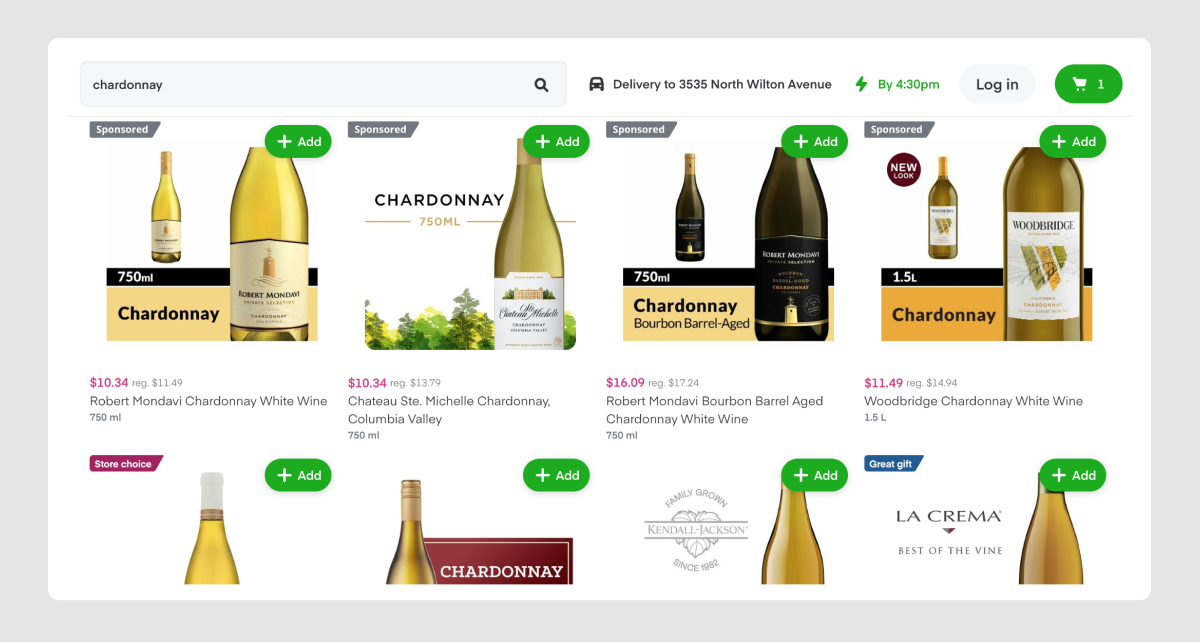Advertising Wine on Instacart
A New Digital Marketing Frontier For Wine
The world of digital marketing is constantly changing and it can be hard to keep up. Trying to break through in an oversaturated market is getting harder by the day. At our wine marketing agency Highway 29 Creative we typically specialize in DTC marketing. This channel can be very expensive to advertise in, but can be worth it since you acquire first party data such as names, emails, and phone numbers. This channel allows direct contact with the end customer and can easily be measured with analytics
With the launch of iOS 14.5 from Apple and other privacy based updates from tech companies, it has become more difficult to attribute conversions accurately and collect first party data. In order to diversify our client’s channel mix, we have embarked on new types of digital marketing in an unlikely place.
Instant delivery services like Instacart and Drizly have been on the rise since 2020 due to the pandemic. People want what they want, and they want it now. While selling via your winery’s website, customers typically have to wait weeks or even months to have their wine delivered directly to their door. Why should they have to wait? Instant delivery services allow instant gratification for your customers. These services fall into a unique overlap between wholesale and DTC marketing, but when you boil it down, you can sell more wine and grow your brand.
How Do You Advertise Wine On Instacart?
We have found the best results for our clients on Instacart compared to other delivery services. They offer multiple formats to advertise in and we found their sponsored product ads to perform best.
Much like a Google Search ad you use for DTC wine marketing, Instacart sponsored product ads rely heavily on keywords.You have full control over which keywords you want to target and how aggressively you want to target them. In sponsored product ads, you are paying for clicks. This means that you only pay when someone actually clicks on your ad instead of paying based on ad impressions like other platforms.
Most digital marketing platforms use a system known as “bidding” in order to determine who gets what ad placement, and Instacart is no different. Your likelihood of winning the auction is determined by how closely your products relate to the keywords users search for. Your budget will also affect your chances of winning. Instacart’s algorithm will suggest bid amounts, however we have not seen these to always be effective and typically spend less than their suggested bid amount. We recommend starting with their suggested bids and optimize your budget based on performance. Some keywords we recommend including in your campaign include: your brand, your product categories, competitor brands.
The main part of a sponsored product ad is the product itself. Using Instacart’s system you can claim your brand and upload UPC codes for products you want to advertise. This is where the reach of your wholesale channel will impact your results. If you sell limited SKUs in limited stores, your ads are less likely to be effective. Instacart will only show ads to users if they are shopping at a store that carries your product. For instance if you are only selling in boutique wine shops that don’t offer Instacart, your reach will be limited. If you distribute with the larger chain stores, you are more likely to have success.
You can choose to sponsor all of the SKUs you sell wholesale or focus on a select few. We have learned it is best practice to focus on your best sellers to concentrate your efforts to maximize results.
Instacart also offers banner ads which get top placement on their search results page. These ads can help attract more attention to your brand, however they are expensive and Instacart itself warns against them for small brands. They charge based on impressions which means you can pay a lot with no guarantee of getting clicks. We only suggest these ads for large brands with a big retail presence.
Starting in August 2022 Instacart released “Brand Pages.” These are landing pages that you can build in order to feature anywhere from 3-20 products offered from your brand. There is a URL that is associated with each landing page that can be linked on everything to your website, digital ads, emails, and social media.
You are able to create evergreen and seasonal landing pages. This means you can create a page that permanently lives on your website. If you are running holiday ad campaigns, you can create pages that directly correlate with your campaigns. These landing pages will track sales associated with each product on each page. This means that you will be able to see how affect your landing page is and can make adjustments to improve.
Instacart Results
Just like all digital marketing strategies, you are not going to see results from your campaigns over night. The Instacart algorithm takes time to learn your products and your brand. Because of this learning delay, it takes months for the campaigns to pick up steam. The more well known your brand already is, the less time this learning phase may take. If you are a smaller brand, this could take a month, or even two. But trust us, it is worth the wait.
Initially you may notice you are not meeting your spending goals. This can be discouraging. If you are able to optimize your ads at least once a week, you will continue your sales increase. The best way to optimize your ads is to take a look at the bid amounts. Instacart’s suggested bids are always changing based on their algorithm.
In the first month running ads, we only saw Instacart spend half of what we allowed it. This was concerning and wanted to see more wine being sold, so we continued to increase individual bid amounts on keywords. We increased the bid amount past what Instacart suggested. After continuing to optimize bids, by the third month we were able to reach our spending goal and double our attributed sales.
We have seen about 90 percent of people who click on the ad, end up making a purchase. This high conversion rate is what leads to bug returns. We saw great returns even from the beginning of the ad process. In the first month of advertising on Instacart, we saw a 2.13x return on ad spend (ROAS). Being that people are buying directly from Instacart, we know that these sales are directly attributed to our sponsor product ads. Through 6 months of running these ads continuously, we found an overall ROAS of 1.93x. Throughout all our month of testing, we have yet to see a ROAS less than 1.5x.
Should I Advertise My Winery On Instacart?
Is Instacart the right fit for you? If you have nationwide distribution, you should be running Instacart ads. Instant delivery services are growing more and more everyday, and this is your opportunity to grow with them.
Stop fighting for the best in store placement when less people are in the stores. This modern day digital end cap will allow you to get your products seen as consumers pivot to online shopping. Meeting your consumers where they are is always the focus of a marketing campaign.





